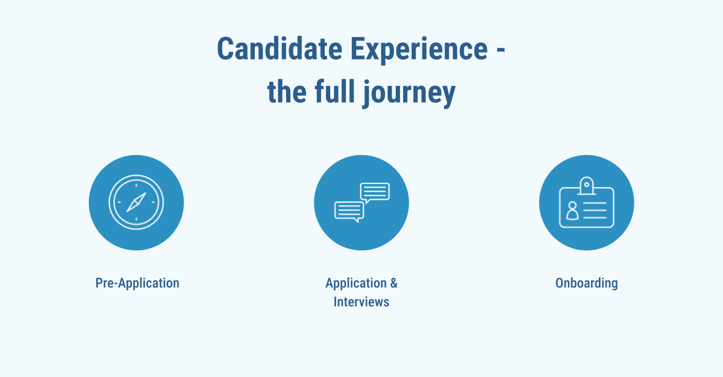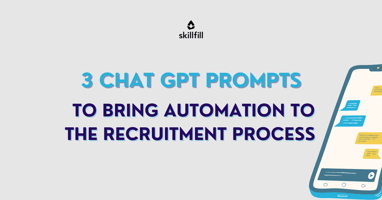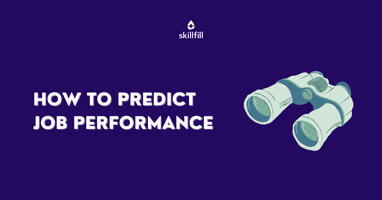In today's digital world, technology has completely transformed the way we live and work. The...
Bad to Good: How to Improve the Candidate Experience - and How Not to.
In the fast-paced world of recruitment, ensuring a positive candidate experience is paramount. It directly impacts your organisation's ability to attract top talent, maintain a strong employer brand, and make successful hires. However, misconceptions and myths about why candidates drop out of the hiring process can lead recruiters down the wrong path.

In this article I will discuss 2 of the most common myths about bad candidate experience, and show the real reasons why candidates drop out. This way you can focus on what really moves the needle. I will wrap up with a summary on how to effectively improve the candidate experience.
What is Candidate Experience and why is it important?
Candidate experience refers to the way in which a potential job applicant views a company's image during the entire recruitment journey. This journey encompasses various stages, starting with the initial job description, proceeding through the interview process, and concluding with post-interview communications. At each of these stages, there exists a valuable opportunity to nurture stronger connections with candidates and convince them of the appeal of joining your organisation.
Fostering a favourable candidate experience can play a pivotal role in the transformation of your preferred candidates into valuable employees. Conversely, a negative candidate experience can lead these top talents to disengage from your recruitment process entirely.
Common misconceptions regarding candidate experience
Myth: Lengthy assessments increase the dropout rate
One of the most prevailing myths in the recruitment world is the belief that longer assessments cause candidates to drop out. It seems reasonable to assume that the more time you ask of a candidate, the less likely they are to complete the process.
Let’s debunk it: A study by Oregon State university and Shaker delves into the issue of assessment length and its impact on candidate attrition. Surprisingly, it finds that the length of assessments doesn't significantly deter candidates from proceeding with the hiring process. In fact, the results suggest that candidates invited to complete assessments with longer time estimates were no more or less likely to take the assessment than those invited to complete shorter ones.
Myth: Gamification is always improving the candidate experience
Gamification is a trend in recruitment and the underlying assumption is that candidates will have fun going through an assessment if it’s gamified. Another underlying assumption is that having more fun leads to higher completion rates and thus to a lower drop out rate of candidates.
Let’s debunk it: In a recent study, researchers found that a game-based assessment was highly correlated with results from an intelligence test, but a paper and pen test testing for the same cognitive abilities led to more positive reactions from candidates. It is important to note that the results are dependent on the exact test construction, but this example shows that gamification is not generally improving the candidate experience.
Real reasons for bad candidate experience
So what are the real reasons behind candidate dropouts?
1. Poor Communication:
Candidates are more likely to drop out if they face a lack of communication from the hiring company. Unclear instructions, delayed responses, or simply not keeping the candidates informed about the process can lead to frustration and dropouts.
2. Unpredictable Delays:
Excessive delays in the hiring process can discourage candidates. A long, drawn-out process, often due to internal inefficiencies, can lead to candidates losing interest.
3. Negative Reactions:
Negative experiences in interviews and assessments, such as a rude interviewer or a confusing test, are significant drivers of dropouts.
4. Perceived Poor Fit:
Candidates who don't see themselves fitting into the company culture or job role are more likely to withdraw from the process.
5. The Allure of Other Offers:
Sometimes, candidates drop out because they've received better job offers elsewhere, highlighting the importance of a streamlined process.
How to provide a great Candidate Experience
On a high level, the candidate experience can be divided into 3 different phases.

Phase 1: Enhancing the Candidate Experience Pre-Application
Before embarking on the job application journey, potential candidates invest time in exploring your company, seeking insights into your organisational culture, history, and accomplishments. It's crucial to provide them with easy access to information about your company, enabling them to assess whether it aligns with their aspirations.
Crafting an Informative Career Site
Your most potent asset for employer branding lies within arm's reach: your career site. This is often the initial destination for candidates seeking information, so ensure that it offers seamless navigation and maintains current content.
Share insights into what sets your company apart, why your team members find it an appealing workplace, and the advantages of joining your ranks.
Harnessing the Power of Social Media
Professional social networks serve as dependable platforms for furnishing candidates with real-time updates on company developments. You can also share recent or upcoming events to provide candidates with a deeper understanding of your company culture. Since many job seekers employ social media for researching potential employers, creating a dedicated careers hashtag can heighten your engagement with them.
Crafting Crisp Job Descriptions
Crafting a compelling job description forms the foundation of attracting suitable candidates and encouraging them to become applicants. Commence your job posting with a hook – information that makes the right candidates feel like it's an ideal match from the outset to catch their attention. Best practices for job advertisements encompass choosing an appropriate title, offering unambiguous insights into job responsibilities and qualifications, and adopting a suitable tone.
Phase 2: Enhancing the Application and Interview Process
In the competitive landscape of talent acquisition, skilled candidates are at the core of your company's success. However, a negative candidate experience during the application and interview process can cause them to reconsider their options and seek opportunities elsewhere.
Streamlining the Application Process
The actual application process is often perceived as cumbersome by candidates, and in a world with numerous career choices, top candidates are less likely to invest their time in a tedious application process. To mitigate this, it's essential to keep the application straightforward by requesting only essential information: the candidate's name, email address, phone number, and resume, with an optional cover letter (it’s better to skip this).
Given that many candidates explore job prospects via mobile devices, it's wise to facilitate mobile-friendly applications. Typing extensive information on a mobile device can be laborious, so provide the option to submit a resume by linking to their LinkedIn profile or portfolio.
Constructing an Equitable Interview Process
Candidates are not just being evaluated; they are evaluating your company as well. Craft an interview process that not only enhances candidate engagement but also aids in identifying the most qualified candidate for each role.
Clear and consistent communication with candidates is crucial for fostering positive relationships and sustaining their engagement throughout the recruitment journey. Promptly follow up after the initial interview, keeping the candidates informed about the next steps and establishing a timeline. Should any delays occur, send a quick note to inform your candidates.
Effective communication is equally vital for candidates who won't proceed in your recruitment process. Even if a specific candidate isn't the right fit for a particular role, they might be suitable for other opportunities in the future. Following up with a phone call or a considerate, personalised email, ideally with constructive feedback, reflects positively on your company and enriches the candidate experience. If your company permits, acknowledge their strengths and offer tips for future success. This level of engagement is highly appreciated by candidates.
Set candidates up for a successful interview experience by providing them with essential information, including the interview date, time, location, and the names of the individuals they'll be meeting. Some organisations are now sharing skill tests in advance to evaluate candidates based on their responses rather than their ability to perform well in interviews.
For these skill assessments with great-fit interview questions, tools like skillfill.ai can be highly beneficial as they can automatically generate skill tests tailored to the specific job requirements. This ensures a fair and bias-free evaluation, allowing candidates to showcase their skills and gain insight into the role's expectations.
The primary objective of an interview should be to assess a candidate's professional competencies and ascertain their compatibility with your team's culture. A structured interview format facilitates this evaluation in a consistent and impartial manner for all candidates.
To respect the candidates' time, aim to keep the number of interviews to a minimum. An overly protracted or excessively interview-heavy recruitment process is more likely to result in a subpar candidate experience.
Training Interviewers
While your talent acquisition team may be well-versed in delivering a positive candidate experience, your interviewers might require guidance. It's essential to provide training to your hiring managers and other interviewers, familiarising them with candidate experience best practices. This encompasses punctuality for interviews, active engagement during discussions, and allowing time for candidate questions.
Soliciting Candidate Feedback
To refine the candidate experience, it's crucial to understand both your strengths and areas for improvement. Collecting feedback from every candidate, not just those you hire, is invaluable.
Phase 3: Ensuring a Seamless Onboarding Experience for New Hires
The onboarding process serves as the initial impression that new hires receive upon joining your organisation. It goes beyond simply acquainting them with your operational procedures; it represents a unique opportunity to extend a warm welcome, ensuring that they feel at ease, confident, and enthusiastic about being part of your team. Keep in mind: Talent knows talent. And they talk to each other.
Conclusion: Not every drop out is bad; focus on what really matters
KPIs play an important role when it comes to measuring the success of your recruitment efforts. One of those KPIs is the candidate satisfaction and closely related: The drop out rate of candidates.
It is intuitive to aim for a 0% dropout rate, but does it make sense? The relation between KPIs like time to hire, quality of hire and candidate satisfaction can be complicated. Just as you shouldn’t expect to hire a person that fits 100% (doesn’t exist) and thus have a high cost of vacancy, because it takes too long to find such a person, it is also not advised to aim for a 0% dropout rate of candidates.
What you should aim for: Focus on improving the steps that you can control, that are mentioned above. If a person drops out because you were too slow to react or didn’t communicate well, then this will cause a dropout rate, which is too high. However, if a person’s motivation to work for you is extremely low (e.g. sometimes candidates go through hiring processes just to train for future hiring processes), then a certain barrier is healthy.
You need to make sure that the barrier makes sense. One such example is skill assessment, which helps to verify skills in the hiring process. This is a necessary step to make sure the quality of hire is in place. If people drop out, although you are using highly relevant questions to verify their skills and have a valid skill test, then a potential dropout rate caused by this barrier is a healthy dropout. It helps you to save time and focus on the people who are more motivated and have showcased their skills.
The quickest way to generate tailored high quality skill assessments is skillfill.ai. Just sign up, upload your job ad and generate the right skill assessment for your exact requirements. Test the software for free 👇
AI-ASSISTED TECH TALENT ASSESSMENT
Get started for free today!



